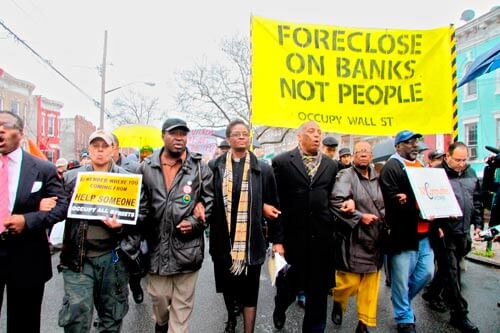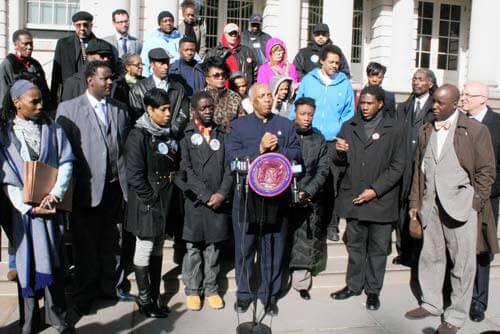On a very drizzly Tuesday afternoon, hundreds of protestors gathered under the trestle of the #3 train at the junction of Livonia and Pennsylvania Aves in East New York carrying a myriad of symbols of home-living: plants, a chair, or a lamp. They carried banners voicing why they were there: “Homes Are For People Not Banks,” “I work, you work, we work (crossed out)-fight, they profit” or “New York Families for New York Families.” One fellow’s sign simply said: 99%.
There were about 400 on New York’s “Occupy Our Homes” foreclosure tour (the opposite of the Occupy Wall Street upper east side millionaires’ homes visit held in September). It is estimated that East New York has five times the state average house foreclosure rate.
This was part of an Occupy Wall Street organized effort with similar actions nationwide called Occupy Our Homes, a day bringing attention to the role banks play in the housing crisis. Since 2007, around 6 million homes have gone into foreclosure and over the next four years it is estimated this number will more than double. Mortgage fraud seems to be increasing as do schemes targeting troubled borrowers.
Councilman Charles Barron, Reverend Patricia Malcolm, joined by Councilman Ydanis Rodriguez, local clergy, union activists led off the march carrying the yellow sign that read , “Foreclose On Banks Not People.”
As they walked with the roar of the train overhead they chanted: Banks got bailed out, we got sold out and after turning onto New Jersey Ave, they began, “We are the nine-nine percent.” Organizers attached yellow and black tape reading “foreclosed” or “occupied” at the foreclosed homes on the tour. Speakers addressed the crowd at each stop. Students from Jefferson High School peered out the windows as demonstrators massed at one house on Pennsylvania Ave.
In “mic-check” fashion–the people’s mic, where the speaker’s sentence is repeated by the crowd in order that everyone can hear–a sentiment was repeated, “we are taking back the houses.” Testimony came from community organizers, clergy, elected officials and people facing eviction. One East New York resident joined the demonstration and told the assembled that his house was being foreclosed that day. At one house they mic-checked: Let’s stop the greed!
More than 20 cities experienced protests with some reoccupations of foreclosed homes, cleaning of abandoned properties, and appearances and actions at now bank-controlled homes.
Behind the dignitaries, a white banner–the width of the street–moved in synch: OCCUPY WALL STREET, the movement nearing merely 12-weeks-old. Drawing the connection between foreclosed homes and the banks and defending individuals facing unfair eviction helps make economic issues, local and personal.
The crowd turned west on New Lots as they walked toward other foreclosures. The last house on the tour at 702 Vermont was festooned with balloons. This three-year unoccupied house was being repaired for a family with two children. Marchers filled the street in front as people spoke from the house’s stoop or standing on a stepladder.
Tasha Glasgow, who for 10 years has been in and out of shelters, the mother, expressed her thanks. Alfredo Carrasquillo, the father, was emotional in his thanks. He is an organizer in Vocal-NY (formerly, New York City AIDS Housing Network), and has been working with others to make the house habitable.
Following various testimonies and as daylight disappeared, food was served at the block party. In solidarity, others went to Malta Street where the house was being foreclosed. Meanwhile, 15 persons, in support, spent Tuesday night at the Vermont Street house. Teams would be helping in repairs and guard against eviction.
(Update: Wednesday night, several police officers appeared around midnight. Councilman Baron was called who spoke to the owner of the house to clarify what the situation was. After much confusion, the NYPD said they were there to watch the house until the morning when the owner of the property (who is also in contact with the occupiers) comes over to talk to the family about the situation to work something out.)

























